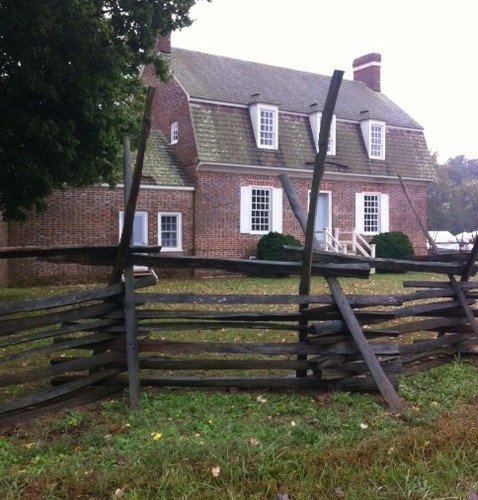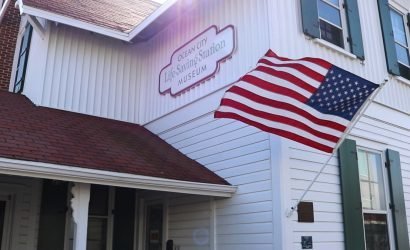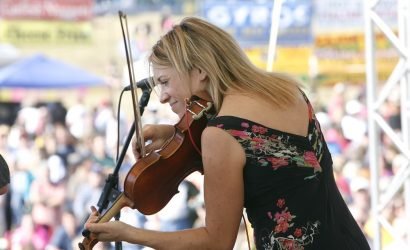Pemberton Park has been a happening place over the past few weeks. With both the Good Beer Festival and the Maryland Autumn Wine Festival being held at the park, we’ve found ourselves at the Salisbury park quite a bit lately. If you didn’t know, there is more to Pemberton Park that great festivals, so we decided to check out the historical location for ourselves in this week’s Day Trippin‘. When entering the large brick house at Pemberton, visitors are greeted by a tour guide outfitted in colonial dress, complete with apron and bonnet. From there, your journey into the past begins.
The story of Pemberton Historical Park originally began in 1726 when Isaac Handy sailed up the banks of the Wicomico River. He docked his boat on a plot of land that he had bought, with the help of his father, from Thomas Pemberton, for whom the land is named. However, the first house that Handy lived in was not the same building seen when visitors arrive at the park today. Originally, he lived in a small cottage located close to the banks of the river. It was not until 1741, when Handy shared his small home with his wife and children, that he began construction of his mansion, Pemberton Hall.
Samuel Handy, Isaac’s father, came to America as an indentured servant and landed in Somerset County in the 1670’s. After working to gain his freedom, Samuel became a wealthy man and had a family with 15 children. Because Isaac was the thirteenth child, and not the first-born son, he could not inherit his father’s land. As a result, Handy traveled to Barbados and become a mariner to make his own fortune.
Because rivers were deemed “the highways” of the colonial era, Issac Handy strategically positioned his land to be in close proximity to the Wicomico River. He continued to make his living as a mariner, shipping goods from coast to coast, as well as through farming. Handy owned 960 acres at Pemberton and used the majority of his land for farming. The original house was kept small because Handy put his wealth in the land and reaped the benefits from his employment.
Handy became a very well established member of society in the Delmarva region. Not only did the profit he received from his land contribute to his wealth, but Handy also married advantageously to Anne Dashiell. As he gained respect in society, Handy also became a colonel in the militia, an Assembly Member in Annapolis, and a Justice of the Peace.
Handy died in 1762 and passed his belongings to his son Henry. When Isaac died, an inventory was taken to assess the extent of his wealth. The inventory included eighteen leather bottom matching chairs, twelve pictures, Prussian blue paint, and among other things a large cupboard displaying silverware. These eighteen chairs show that Handy made a prosperous living because most people during this time would not have enough space in their homes for eighteen chairs, nor could they afford to have this many chairs built.
The twelve pictures and Prussian blue paint show that Handy could afford to have his walls decorated. Historians know that Handy had twelve pictures on the Great Room’s wall because the original wall still has holes from nails that held the pictures up. The Prussian blue paint is an even truer representation of Handy’s fortune because paint was expensive and this particular color had to be imported from Europe. As the name implies, it came from Prussia, modern day Germany. By detailing this paint color in the inventory, the walls of Pemberton’s Great Room could be repainted to match the original décor. The rest of the rooms are painted with a color visitors today would view as “egg shell” or beige. Although in modern times it may seem like a very bland color, it was seen as “royal” in the colonial era. Handy’s china case or cupboard had glass panes to display his dishes and silverware in. Placed in the Great Room, it allowed all who visited to see the expensive tableware that he owned.
The house itself is also a testament to Handy’s affluence. The cottage that he and his family had originally lived in was similar to that of the homes of the rest of the Eastern Shore population. However, Pemberton Hall was massive compared to these houses. The first room that visitors of the past and present enter is the Great Hall, where Handy would have entertained guests and done business. This room could have also been used for dances and parties because it was so large for the time.
Apart from this room, there is an entire upstairs for bedrooms while in comparison, other common homes only had lofts for this purpose. There are also family rooms that were used for work and play while the family was not entertaining. A separate kitchen room was later added when Henry inherited the building. Another interesting fact about the house is that its front door is on the opposite side of the house than a modern visitor would expect. The façade of contemporary homes face the street, and in Handy’s time the river was “the highway.” So by this logic, the door facing the river would have been the front door.
One of the main objectives at Pemberton Hall is to make everything as accurate as possible. This is why historians use artifacts such as the inventory to create an experience that is as realistic as possible for tours at Pemberton Hall. All items on display that are not originals have been verified as historically accurate for the time period through historical documents.
After visiting the great hall, tours are lead into the family room that houses a small table and chairs. This would have been a multi-purpose space where the family could have done many chores, and if there was time, relax. This would have also been the space that Anne would have taught her children mathematics and how to read. Anne also ran the plantation for most of the time. Because her husband was on his ship for part of his business, he was not always at home, leaving Anne in command of the estate.
After visiting the small corner rooms allotted for the family’s activities, guests travel into the kitchen to learn about the hardships of the colonial era. In the present day, we take many things for granted because many items are available for a fairly cheap price, right at our finger tips. However during Handy’s time, these items were too expensive to purchase, so they were often made at home. Every meal served at Pemberton Hall was not only hand cooked, but was prepared completely from scratch. For example, if the Handy family wanted to have chicken for dinner, someone had to catch a chicken, break its neck, pluck it, drain out the blood, then begin to cook it. While today, we just bring one home from the grocery store and pop it in the oven.
Other items that had to be made on the farm included eating utensils, lanterns, and cups. These items could be made from the horns of animals such as cows. Once removed, the horn was heated and rolled and pounded into whichever instrument needed to be made. If horns were rolled thin enough they became translucent, letting some light through. These were used as panes in lanterns instead of glass. The original name for lanterns was actually “lan-horns” for this reason. Candles and soaps were also made at home. Soap however was considered hard on one’s skin, most likely due to the fact that people of the time only took three or four baths a year. People instead believed that the natural oils on their skin protected them from disease.
After leaving the kitchen, we walked out of Pemberton Hall to a view of the farmland that once belonged to Isaac and his sons. We also walked down the many nature paths that offer wonderful views of the Wicomico River. Pemberton is a great site to visit for the History buff as well as the nature lover…or the causal Day Tripper.
Until next time…









